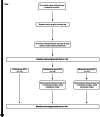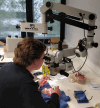Randomized Controlled Trial: Acquisition of Basic Microsurgical Skills Through Smartphone Training Model
- PMID: 39712383
- PMCID: PMC11661746
- DOI: 10.1097/GOX.0000000000006403
Randomized Controlled Trial: Acquisition of Basic Microsurgical Skills Through Smartphone Training Model
Abstract
Background: Microsurgery is essential in various surgical specialties, but learning these skills is challenging due to work hour limitations, patient safety concerns, documentation time, and ethical objections to practicing on live animals. This randomized controlled trial compares 2 microsurgical training models: the smartphone model and the microscope model.
Methods: Thirty students without prior microsurgery experience were randomized into 3 groups: control (CG), smartphone (SG), and microscope (MG). Participants performed microsurgical skill tests and a chicken femoral artery anastomosis before and after 10 hours of standardized training according to their assigned models. The CG performed the test twice without training. Performance was assessed by time to complete the anastomosis, University of Western Ontario Microsurgery Skills Assessment scale, anastomosis patency, and time to complete the round-the-clock test.
Results: No significant differences were observed among groups at baseline. Significant improvement in anastomosis time was achieved in the MG (27.4 minutes, P = 0.005) and SG (27.0 minutes, P = 0.005), but not in the CG (13.1 minutes, P = 0.161). On the University of Western Ontario scale, the MG improved by 6.0 points (P = 0.002), the SG by 5.1 points (P = 0.006), and the CG by 2.4 points (P = 0.009). Patency rate significantly improved in the MG and SG (P = 0.002) but not the CG (P = 0.264). Round-the-clock time improved in all groups (P < 0.001).
Conclusions: Basic microsurgical skills can be effectively learned using the smartphone training model, with performance improvements comparable to the microscope model. Its main limitation is the lack of stereoscopy.
Copyright © 2024 The Authors. Published by Wolters Kluwer Health, Inc. on behalf of The American Society of Plastic Surgeons.
Conflict of interest statement
The authors have no financial interest to declare in relation to the content of this article.
Figures







References
-
- Milling R, Carolan D, Pafitanis G, et al. . Microtools: a systematic review of validated assessment tools in microsurgery. J Plast Reconstr Aesthet Surg. 2022;75:4013–4022. - PubMed
-
- Abi-Rafeh J, Zammit D, Mojtahed Jaberi M, et al. . Nonbiological microsurgery simulators in plastic surgery training: a systematic review. Plast Reconstr Surg. 2019;144:496e–507e. - PubMed
-
- Yee A, Padovano WM, Rowe AG, et al. . The effect of surgical video on resident performance of carpal tunnel release: a cadaveric simulation-based, prospective, randomized, blinded pilot study. Plast Reconstr Surg. 2020;145:1455–1463. - PubMed
-
- Nehme J, Sodergren MH, Sugden C, et al. . A randomized controlled trial evaluating endoscopic and laparoscopic training in skills transfer for novices performing a simulated NOTES task. Surg Innov. 2013;20:631–638. - PubMed
LinkOut - more resources
Full Text Sources
